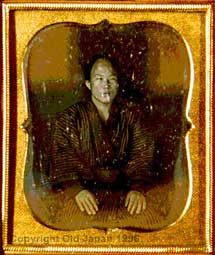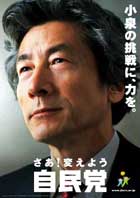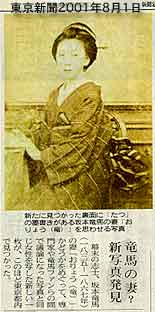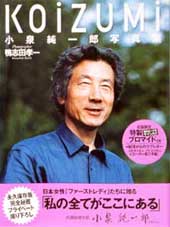PhotoHistory 2001: Difference between revisions
No edit summary |
(No difference)
|
Revision as of 19:47, 10 September 2009
Chronological history of photography in Japan in 2001 (Heisei 13)
Researched and compiled by Philbert Ono
In the early morning of Jan. 1, NHK broadcast a special two-hour TV program called "Portraits of Japan at the Century's End - Japan As Seen by 1000 Photographers" The program featured photographs of people, landscapes, and social issues in today's Japan. A few of the photographers were also shown pursuing their own pet themes such as an island that has depopulated after the monstrous Seto Ohashi Bridge crossed over it, changes in rural villages over a 20-year period, and weeds sprouting out of concrete/asphalt-covered ground. NHK also distributed questionnaires to all the photographers asking why they were pursuing the particular theme and what they wanted to convey. The 1,000 photographs were gathered and coordinated by the Japan Professional Photographers' Society (JPS).
On Jan. 3, NHK broadcast its "NHK Special" TV program featuring 100 of the most famous mountain peaks of the world photographed during the past four years by SHIRAKAWA Yoshikazu, a renown alpine photographer.
On the evening of Jan. 26 (Fri.) at Shin-Okubo Station on the Japan Railways Yamanote Line in Tokyo, a drunken man fell off the train platform and onto the tracks. Twenty-six-year-old Lee Su Hyon and 47-year-old photographer SEKINE Shiro then immediately jumped onto the tracks to rescue the 37-year-old man named SAKAMOTO Seiko, but all three were killed by an oncoming train that could not stop in time. The sad news makes top headlines. Sekine was employed by a photo studio in Tokyo's Bunkyo Ward and lived in Yokohama with his mother.
On Jan. 29, Prime Minister Yoshiro MORI and Foreign Minister attended the funeral for Lee, a South Korean who was a student studying at a Japanese language school. On the same day, Sekine's funeral, held in Yokohama, was attended by IBUKI Bunmei, the head of the National Public Safety Commission which oversees the National Police Agency and by OTSUKA Mutsutake, the president of JR East. Lee and Sekine also received letters of appreciation posthumously from the Japanese government and Metropolitan Police Department.
Later in April, a bronze, memorial plaque dedicated to the Sekine and Lee was unveiled on a wall at Shin-Okubo Station. Lee's parents attended the unveiling ceremony as well as OTSUKA Mutsutake, the president of East Japan Railway Co., who gave a speech. The plaque reads in Japanese and Korean, "Here we memorialize the noble spirit and courageous act of the two men forever."
On Jan. 9, a US marine from Camp Hansen in Okinawa lifted up the skirt of a 16-year-old high school girl and took a picture of her underwear with a digital camera. This caused another uproar in Okinawa, leading the prefectural assembly to pass a resolution for the stricter discipline and reduction of US Marines in Okinawa. Then on Jan. 23, in an e-mail "pep talk" message to 13 subordinate officers, Marine Lt. General Earl Hailston (the top commander of US forces in Okinawa) called the Okinawan government officials "all nuts and a bunch of wimps" in reaction to the assembly's resolution. This further enraged the Okinawans, and Hailston called on Okinawan Governor Keiichi Inamine on Feb. 8 to apologize for the e-mail note that was somehow leaked. The Governor did not make eye contact with the general and declined to shake his hand during the 15-min. meeting.
In Jan., a group of young (around college age) men and women photographers pooled their money and rented a small space in Shinjuku, Tokyo to open their own photo gallery called photographer's gallery. Citing the lack of exhibition space for pro photographers in Tokyo, they decided to establish their own space to show their work. The gallery is managed and operated by the group of photographers numbering around 15. Address: Shinjuku 2-16-11-401, Shinjuku-ku, Tokyo. Phone: 03-5368-2631
On Feb. 23, well-known German newspaper Sueddeutsche Zeitung published a color photograph of Japanese Crown Prince Hiro and Crown Princess Masako on the cover of its free weekly magazine insert called Sueddeutsche Zeitung Magazin. It was the Crown Prince's 41st birthday. However on the following day, the Japanese Embassy in Berlin lodged a protest against the photograph. The words "Tote Hose" (dead trousers), a German slang for impotence, was printed over the Prince's trousers, and the caption read "The oldest monarchy in the world is in crisis." It was in reference to the Imperial couple still being childless while the Crown Prince is in line to be the next emperor of Japan.
On Feb. 26, the two top editors of the magazine published an apology in the newspaper saying that they did not want to offend the Crown Prince and Crown Princess and that they would apologize to the Japanese ambassador. (Later in April, the Imperial Household Agency announces that the Crown Princess "might be pregnant." In May, the Crown Princess was officially declared as three months pregnant.)
In March, the prestigious KIMURA Ihee Award is jointly awarded to NAGASHIMA Yurie (for Pastime Paradise), NINAGAWA Mika (for Pink Rose Suite and Sugar and Spice), and HIROMIX (for Hiromix Works). It was the first time that the award was given to three women at the same time. They each received 500,000 yen as part of the award. (A solo winner receives 1 million yen.) An exhibition showing the winners' work is also held at the Minolta Photo Space in major Japanese cities starting in Tokyo from April 24 to May 14. The awards ceremony was held on April 24 at Yurakucho Mullion in Ginza, Tokyo. The selection of these three women also received some negative criticism.
On March 10, ARAKI Nobuyoshi, Japan's most famous (or infamous) photographer, opens his official Web site at http://www.arakinobuyoshi.com/ . The site lists his publications and exhibitions as well as photos.
On March 23-25, Photo Expo 2001, consisting of the Japan Camera Show and Photo & Video Accessory Show, is held at the spacious Tokyo Big Sight for the first time, breaking away from Ikebukuro Sunshine City which had been the venue for several years.
On April 26, newly elected Prime Minister Jun'ichiro Koizumi appoints 73-year-old MORIYAMA Mayumi as the Justice minister in his cabinet. She is one of five women in the Cabinet, the most ever. She also happens to be the president of JCII (Japan Camera and Optical Instruments Inspection and Testing Institute) which operates the JCII Camera Museum, JCII Photo Salon, and JCII Library in Tokyo. This is her third cabinet appointment after serving as chief Cabinet secretary under Prime Minister Toshiki Kaifu and later as education minister under Kiichi Miyazawa.
 On May 11 in London, England, a rare daguerreotype portrait (see picture) of a Japanese sailor named Sentaro i呾˜Yjor Sampachi (aka "Sam Patch") owned by collector Terry Bennett was auctioned by Christie's for 32,000 pounds. Sentaro was the ship's cook on the Eiriki Maru which was shipwrecked in the Pacific Ocean and taken to San Francisco in Feb. 1851. Portraits of the Eiriki Maru's 18 crew members were taken by a photographer from Baltimore while they stayed in San Francisco from Feb. 1851 to March 1852. This daguerreotype was one of them and it is among the first photographs of a Japanese. Read more about Sentaro in an article written by Old Japan.
On May 11 in London, England, a rare daguerreotype portrait (see picture) of a Japanese sailor named Sentaro i呾˜Yjor Sampachi (aka "Sam Patch") owned by collector Terry Bennett was auctioned by Christie's for 32,000 pounds. Sentaro was the ship's cook on the Eiriki Maru which was shipwrecked in the Pacific Ocean and taken to San Francisco in Feb. 1851. Portraits of the Eiriki Maru's 18 crew members were taken by a photographer from Baltimore while they stayed in San Francisco from Feb. 1851 to March 1852. This daguerreotype was one of them and it is among the first photographs of a Japanese. Read more about Sentaro in an article written by Old Japan.
On May 11, the Japan Professional Photographers Society (JPS) finally received official approval from the Ministry of Science, Technology, and Culture as an incorporated, non-profit association .
 In May, the election poster of hugely popular Prime Minister Jun'ichiro Koizumi becomes a surprise best-seller. The initial printing of 65,000 copies and subsequent printings quickly ran out. By the end of May, a little more than a week after the poster first went on sale for 50 yen each, 300,000 copies were printed and sold. By July, a whopping 600,000 posters were sold, or as many as 10,000 copies per day.
In May, the election poster of hugely popular Prime Minister Jun'ichiro Koizumi becomes a surprise best-seller. The initial printing of 65,000 copies and subsequent printings quickly ran out. By the end of May, a little more than a week after the poster first went on sale for 50 yen each, 300,000 copies were printed and sold. By July, a whopping 600,000 posters were sold, or as many as 10,000 copies per day.
The posters were to be sold only to local Liberal Democratic Party offices, but the gift shop at the party's headquarters in Tokyo started seeing over 100 people a day lining up to buy the poster. The poster shows a head shot of a forward-looking Koizumi with the slogan, "Lend your strength to Koizumi's challenge" and "OK, let's reform." It was a different pose from the usual, stodgy mug shots shown in the usual election posters. Large wallpaper images of the poster are available at the Liberal Democratic Party's Website at http://www.jimin.or.jp/jimin/koizumi/p-c.html
Also in May, the Nikon D1x is marketed with a retail price tag of 590,000 yen. With a 5.47-megapixel CCD, this top-of-the-line, digital SLR camera is a leap above its predecessor, the Nikon D1 (marketed in 2000), which had only 2.74 megapixels and a higher price tag of 650,000 yen. Like the Nikon D1, the D1x becomes an instant hit product among professionals.
During Jan. to June 2001, Japanese camera makers sold a total of 13.24 million film-based, still cameras in the domestic and overseas markets. This was an 11% decrease from the same period in the preceding year. Meanwhile, sales of digital still cameras continued upward at 5.91 million units sold. This includes a 86% increase in domestic sales and a 34% increase in exports.
In June, mobile phone company J-Phone introduced its new "Sha-Mail" service with cell phones having a built-in camera. The user can take a picture with the cell phone and send it to another user and receive photos from others.
In July, the Asahi Pentax LX professional SLR manual-focus camera is discontinued after being in production since June 1980. Asahi Optical, the manufacturer, decided to stop production due to the difficulty of procuring electronic components for the camera.
In the evening July 12, the Seattle Mariners issued a statement saying that baseball stars Ichiro SUZUKI and Kazuhiro SASAKI will no longer talk to the Japanese press due to a number of incidents which infringed the players' rights to privacy. On July 13, the Seattle Times reported that the last straw occurred on the morning of July 12 when Japanese paparazzi photographers took pictures of Ichiro as he was backing out of his garage. See article here. Ichiro complained that the photographers almost forced him to stop the car. This upset the credentialed Japanese press who respect the players' privacy, but could not control the non-credentialed people working for scandal-oriented, weekly photo magazines like Friday. In another article in the Seattle Times, Sasaki was quoted as follows: "Unfortunately, I think all Japanese media is the same. They all have the same standard. It's not just one company. A lot of them are doing it. Most (photographers) use fake names and sell their pictures to different companies."
On July 25,the Nikon D1H is marketed at 470,000 yen. With a 2.74-megapixel CCD, this is a faster version of the top-of-the-line Nikon D1x. The maximum continuous shooting speed is 5 shots per second for a maximum burst of 40 shots. (Compared to the D1x's 3 shots per sec. and maximum burst of 9 shots.) This is also a major improvement (thanks to a much larger buffer memory) over the old Nikon D1 which could only shoot 4.5 shots per sec. up to 21 continuous shots.
From July 24 to September 30, the Ansel Adams Center in San Francisco, California held the "Modern Photography in Japan: 1915-1940" photo exhibition featuring 92 fine-art works by 31 photographers including NOJIMA Yasuzo, NAKAYAMA Iwata, UEDA Shoji, FUKUHARA Shinzo and Roso, and SHIOTANI Teiko. Organized by The Friends of Photography at the Ansel Adams Center, the works were borrowed from the collections of the National Museum of Modern Art, Kyoto; the Tokyo Metropolitan Museum of Photography; and private collections.
 From Aug. 1 to Sept. 2, the Kyoto National Museum in Kyoto held the "SAKAMOTO Ryoma: Ryoma and His Contemporaries exhibition showing Ryoma's various letters and personal effects from the museum's collection. Ryoma (1835-67) was a pro-Imperialist activist (later assassinated) who sought to dismantle the shogunate system and restore the Japanese emperor to power. Today, he is revered as a popular hero.
From Aug. 1 to Sept. 2, the Kyoto National Museum in Kyoto held the "SAKAMOTO Ryoma: Ryoma and His Contemporaries exhibition showing Ryoma's various letters and personal effects from the museum's collection. Ryoma (1835-67) was a pro-Imperialist activist (later assassinated) who sought to dismantle the shogunate system and restore the Japanese emperor to power. Today, he is revered as a popular hero.
The exhibition also had a collection of photographs, one of which stirred much debate. The photo in question was of a young woman in kimono. The debate was about whether she was Ryoma's wife.
She is posed in a photo studio owned by well-known photographer UCHIDA Kuichi. The photograph had been acquired by vintage photo dealer IZAKURA Naomi in Tokyo (and published in Portraits in Sepia), and the museum realized that the woman was the same in another known photograph of the woman in a photo album owned by the Iguchi family. (The Iguchi family are the descendants of the owner of the Omiya inn in Kyoto where Ryoma was assassinated.) Both photographs were obviously made during the same sitting (around 1872) in the same photo studio, but she is posed slightly differently. In Ms. Izakura's photo, the woman is sitting on a chair. In the Iguchi album's photo, she is standing. The Iguchi family had two albums which together contained over 70 portraits of Ryoma's well-known and close associates. Most people do not believe that the photo in the Iguchi album (found 20 years ago) was Ryoma's wife Oryo because the photo studio was for high-ranking government officials.
 However, some believe that the woman is Oryo because the name "Oryo" was written next to the photograph in the album. It is also the only female portrait found in the Iguchi albums. With the discovery of Ms. Izakura's photograph, the debate was rekindled because the word "Tatsu" was written with an ink brush on the back of the photo. "Tatsu" (meaning dragon) is another reading for the same kanji character used for "Oryo."
However, some believe that the woman is Oryo because the name "Oryo" was written next to the photograph in the album. It is also the only female portrait found in the Iguchi albums. With the discovery of Ms. Izakura's photograph, the debate was rekindled because the word "Tatsu" was written with an ink brush on the back of the photo. "Tatsu" (meaning dragon) is another reading for the same kanji character used for "Oryo."
The exhibition also showed a portrait of an old woman who was Ryoma's widow, and she had a strong resemblance to the younger portraits.
Incidentally, when the museum announced to the press the connection between Ms. Izakura's photograph and the photo in the Iguchi family album, they did not credit Ms. Izakura as the founder and owner of the newly discovered photograph. Consequently, she was not mentioned at all in the news reports (including the article in the Aug. 1, 2001 issue of Tokyo Shimbun pictured above and a Japan Times article in the Aug. 2, 2001 issue). Read more about the exhibition at the museum's " Web site in English.
On Aug. 6, Nikon Corporation revealed that it was thinking about withdrawing from the APS (Advanced Photo System) camera market amid slumping APS camera sales in the face of soaring popularity of digital cameras. Nikon is one of the five companies (others being Canon, Minolta, Fuji Photo Film, and Eastman Kodak) that developed the APS system (introduced in April 1996). It is also the first among the five to make such an announcement.
 On Aug. 7, the last issue of FOCUS magazine went on sale. In early July, publisher Shinchosha announced that the magazine would cease publication due to the low circulation and resulting red ink which it sustained since 1992. The magazine was first published in Oct. 1981 and once reached a peak circulation of 2 million.
On Aug. 7, the last issue of FOCUS magazine went on sale. In early July, publisher Shinchosha announced that the magazine would cease publication due to the low circulation and resulting red ink which it sustained since 1992. The magazine was first published in Oct. 1981 and once reached a peak circulation of 2 million.
In recent months, it could hardly sell more than 200,000 copies. The magazine opened up a whole new genre (dubbed shashin shukanshi or weekly photo tabloid) in Japan's magazine publishing industry by providing celebrity gossip, scandals, nudity, and other sensational stories always illustrated with photographs usually taken by paparazzi photographers.
Its huge success prompted other major publishers to start similar publications such as Friday by Kodansha. The publisher claimed that the magazine's demise actually started in 1986 when actor and comedian Beat Takeshi (aka Takeshi Kitano) and his gang stormed the offices of Friday magazine and physically attacked the staff in anger for publishing a story about Takeshi's illicit affair with a college coed. This widely publicized incident gave a bad name to these weekly photo tabloids and circulation dropped dramatically. In the last issue of Focus, Beat Takeshi ironically gives a eulogy to Focus, expressing his sadness and regret for the magazine's folding.
The Yokohama Triennale 2001, Japan's first, large-scale, international modern-art exhibition, opened on Sept. 2 for a 10-week run until Nov. 11. A few photographers were among the 110 leading artists from 38 countries featured at over a dozen venues scattered around Yokohama's waterfront, especially the Minato Mirai area (with the Pacifico Yokohama Exhibition Hall as the main venue). The Japanese photographers included AKASEGAWA Genpei and SUGIMOTO Hiroshi.
 On Sept. 5, a photo book titled KOiZUMi showing photos of Prime Minister Jun'ichiro Koizumi went on sale in Japan. It was the first time ever for a Prime Minister of Japan to have a photo book published while in office. The book has 94 photos showing the Prime Minister in various locations and times.
On Sept. 5, a photo book titled KOiZUMi showing photos of Prime Minister Jun'ichiro Koizumi went on sale in Japan. It was the first time ever for a Prime Minister of Japan to have a photo book published while in office. The book has 94 photos showing the Prime Minister in various locations and times.
The most recent photos show him vacationing in Hakone in August. Photos of his electioneering, his sons, and his younger days were mostly taken by KAMOSHIDA Koichi who has been photographing Koizumi for about 10 years.
The first printing of the book included a real glossy photo with his reproduced autograph. The book, published by Futabasha, sold out at most bookstores within a few days.
Two significant cameras have been discontinued in late 2001. One is the Contax AX which featured the world's only "back focusing AF" system where the film plane moved to achieve focus. Manual-focus lenses could thereby be used with the camera AF system. The camera was first introduced in April 1996.
Another venerable camera that has been discontinued is the Nikonos-V underwater camera from Nikon. This camera was first marketed in 1984, and long served as the camera of choice for underwater photography. The Nikonos camera series go way back to 1963 with the Nikonos I. Since Nikon has no plans to offer a successor model, the Nikonos will no longer exist (except for used ones).
From Nov. 17 to Dec. 2, the city of Sagamihara in Kanagawa Pref. held its first annual Photo City Sagamihara 2001 photo festival. The events included an exhibition by photo contest winners (both pros and amateurs), a slide show by local art college students and talk by MORIYAMA Daido, and a slide lecture by ENARI Tsuneo and OISHI Yoshino.
On Nov. 13-18, PhotoGuide Japan held the Kyoto International Photo Showcase 2001 photo exhibition and slide show at the Kyoto International Community House. The photographers included IZIMA Kaoru and Spencer Tunick.
On Nov. 22, Tokyo-based Yodobashi Camera opened its first store in the Kansai region in front of JR Osaka Station/Hankyu Umeda Station.
 On Dec. 8-12, the Japan Professional Photographers Society (JPS) held a charity photo exhibition at the Tokyo International Forum, A Gallery. The proceeds were to be given to the families of the photographers who were victims in the terrorist attacks in New York and Washington, DC. The opening ceremony on the first day was attended by U.S. Ambassador Howard Baker who gave a short speech before taking a tour of the exhibition and giving the first donation. He remarked that he too was an avid shutterbug.
On Dec. 8-12, the Japan Professional Photographers Society (JPS) held a charity photo exhibition at the Tokyo International Forum, A Gallery. The proceeds were to be given to the families of the photographers who were victims in the terrorist attacks in New York and Washington, DC. The opening ceremony on the first day was attended by U.S. Ambassador Howard Baker who gave a short speech before taking a tour of the exhibition and giving the first donation. He remarked that he too was an avid shutterbug.
Some 670 prints by about 241 JPS members were available for spot sale, with prices ranging from 10,000 to 50,000 yen. Some 370 pictures were sold, yielding 5,835,111 yen plus 390,000 yen in individual donations. After subtracting expenses, a total of 4 million yen ($30,972.50) was sent to the U.S. families on Dec. 20, 2001.
In the Dec. 16 issue of the The Japan Times English newspaper, the Sunday Timeout column featured a series of articles about photography in Japan titled The Big picture.
In Dec., Canon markets the top-of-the-line, EOS-1D professional digital camera to compete directly against the well-entrenched Nikon D1x. While based on the film-based EOS-1V, the EOS-1D features a CCD with 4.15 effective megapixels, a maximum shooting speed of 8 shots/sec., and maximum burst of 21 shots during continuous shooting. It thus offers both fast speed and top image quality. The CCD size makes the lens focal length become equivalent to 1.3 times the normal length. The target user is the press photographer.
2001's most memorable photo books (random order): Minzoku (Ethnic Tribe) by ONUMA Shoji, KOiZUMi by KAMOSHIDA Koichi, Landscapes with a Corpse 1999-2000 by IZIMA KAORU, Utatane by KAWAUCHI Rinko, Naked Women edited by Phil Braham, The Kabuki-za by SHINOYAMA Kishin, The History of Japanese Contemporary Photography edited by JPS (See http://photojpn.org/books/index.html for book reviews.)
Next: PhotoHistory 2002